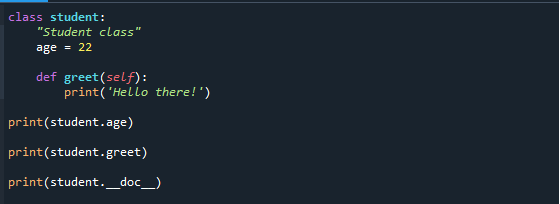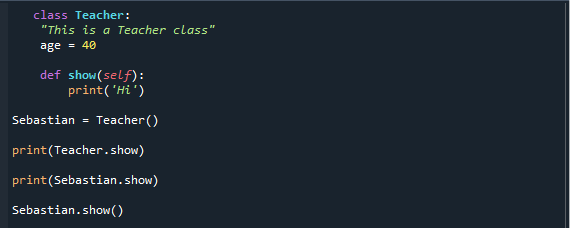Classes in Python
Everything in Python is an object, and a class is how an object is defined. A class serves as the foundation for all data in Python. They serve as the foundation of object-oriented programming and stand in for the things you want your programs to simulate. To create objects, which are particular instances of a class, you employ a class.
A class specifies both the information that can be linked to an object’s properties as well as the general behavior that a group of related objects may exhibit. Because classes can inherit from one another, you can develop a class that expands the capabilities of an already-existing class. In Python, which is object-oriented, this is a relatively common technique.
The Python class variables are shared by all instances of an object in a class. Variables are defined when a class is formed. They aren’t defined in any of the class’s methods.
Objects in Python
As we mentioned earlier, everything in Python is an object and an instance of a class. Built-in types and user-defined classes were distinguished in early iterations of Python, but they are now entirely interchangeable. Classes and types are things in and of themselves and are of the type. The type() function of Python can be used in order to determine the type of any object.
Attributes are the data values we store inside an object, and methods are the functions we associate with the object. Some built-in object methods, like those of strings and lists, have already been employed.
Let’s look at some examples and put them into practice to acquire a better understanding.
Example 1
In this example, we’re going to define a class in Python. Class definitions in Python start with the class keyword, just like function definitions do with the def keyword. A brief description of the class can be found in the first string within the class. It is called a docstring. This is actually recommended, though not required. Here is a brief explanation of the classes:
All the attributes of a class are declared in a new local namespace generated by the class. Data or functions can be attributes. Additionally, it contains special properties that start with double underscores, or for instance, __doc__ provides us with the class’s docstring.
When a class is defined, a new class object having the same name is produced. We can instantiate new objects of that class and access their various attributes by using this class object.
Here, you can see that a student class and a function with the name ‘greet’ have both been generated. The age is displayed afterward. In the final line of code, we called the greet() function and a unique attribute.
"Student class"
age = 22
def greet(self):
print('Hello there!')
print(student.age)
print(student.greet)
print(student.__doc__)
The output is shown here.
Example 2
The Student class, which has the attributes of age and name, was constructed using the code below. We have also given them value. You can see that the ‘self’ was a parameter we gave to the display function. The same class attribute is referred to using this phrase. A new instance object with the name “std” has been created. We may access the class’s characteristics by utilizing it.
age = 20
name = "Jackie"
def show (self):
print("Age: %d \nName: %s"%(self.age,self.name))
std = Student()
std.show()
The student’s age and name are displayed in the screenshot below.
Example 3
We go into detail in the final example of this post on how to build a class object in Python. Please be aware that you can access various attributes via the class object. Additionally, it can be used to produce new instances of that class’s objects. The process of creating an object is comparable to calling a function.
A screenshot from the example is shown below. The word “std” will be used to create a new object instance. The prefix of the object’s name provides access to the object’s attributes.
Data or a procedure can be an attribute. The related functions of a class are the methods of that class. This indicates that the Teacher. show will be a method object because it is a function object (an attribute of a class). Verify the code provided below.
In this case, a class teacher is initially created. We have written a function called “show” and supplied the argument “self” into it. A class object is then constructed after that. The method to display the output has also been called.
"This is a Teacher class"
age = 40
def show(self):
print('Hi')
Sebastian = Teacher()
print(Teacher.show)
print(Sebastian.show)
Although we called the method Teacher.show() without any arguments, you may have noticed the parameter ‘self’ in the function declaration inside the class. This is so because the object itself is always supplied as the first argument when an object calls one of its methods. Thus, Teacher.show() becomes Teacher.show (Sebastian).
Generally, invoking a method with a list of arguments is almost equal to invoking the corresponding function with a list of arguments that are made by placing the object of that method before the first argument. For these reasons, it is important that the object itself be the first argument of the function. Typically, this is referred to as ‘self.’
The outcome of the code above is seen in the screenshot down below.
Conclusion
Here we have discussed Python classes. Hopefully, you are already aware of the key ideas behind Python classes. Here, you may also find a variety of thorough examples that you can use to run through and choose the key concepts to incorporate into your projects.






